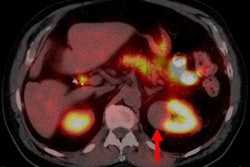Monday, November 28 | 11:10 a.m.-11:20 a.m. | SSC06-05 | Room N228
By better analyzing renal cell carcinoma, MRI could be a beneficial tool for determining whether patients with the disease should receive surgery or other treatments, say U.S. researchers.Dr. Carolina Parada Villavicencio, a body imaging research fellow at Northwestern Memorial Hospital in Chicago, and colleagues are developing a multiparametric MRI model to characterize subtypes of renal cell carcinoma and overcome the challenge of differentiating the disease from oncocytoma and angiomyolipoma.
Between January 2010 and September 2015, the researchers analyzed more than 200 renal masses using a variety of MR imaging techniques that included T1- and T2-weighted signal intensity, diffusion-weighted imaging (DWI), and dynamic enhancement features. Renal pathology included clear cell renal cell carcinoma, papillary renal cell carcinoma, chromophobe renal cell carcinoma, oncocytoma, and angiomyolipoma.
MRI features derived from T2-weighted signal intensity and apparent diffusion coefficient (ADC) values were statistically significant in predicting and distinguishing clear cell renal cell carcinoma with a positive predictive value (PPV) of 90%. In addition, DWI and T2 signal intensity were statistically significant for papillary renal cell carcinoma (PPV of 88%) and angiomyolipoma (PPV of 93%). MRI had the lowest PPV for chromophobe renal cell carcinoma (46%) and oncocytoma (21%).
"In our study, MRI features to discriminate renal cell carcinoma were statistically significant for clear cell and papillary renal cell carcinoma, as well as angiomyolipoma," Parada Villavicencio told AuntMinnie.com. "However, differentiation of chromophobe renal cell carcinoma and oncocytoma still remains challenging with MRI."


.fFmgij6Hin.png?auto=compress%2Cformat&fit=crop&h=100&q=70&w=100)





.fFmgij6Hin.png?auto=compress%2Cformat&fit=crop&h=167&q=70&w=250)











